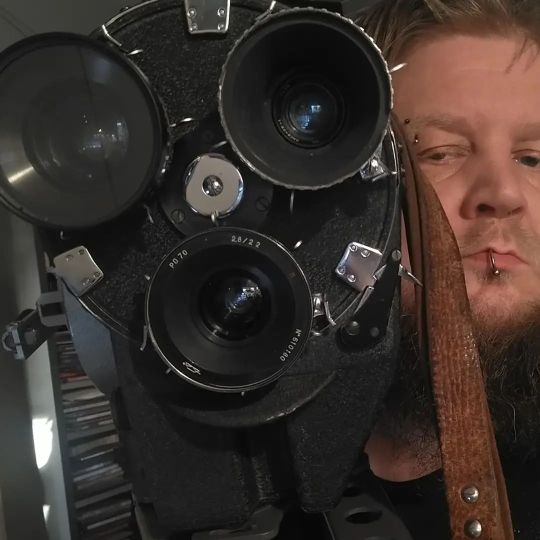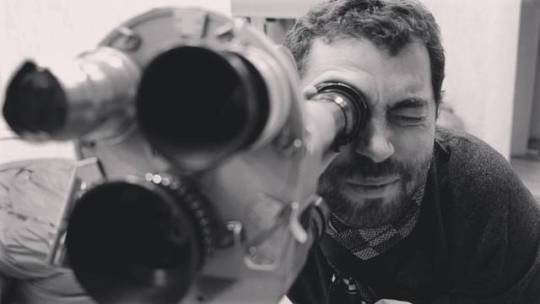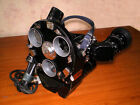#konvas
Photo

Vintage Soviet Soyuz-11 Konvas Motion Picture Camera Issued to Alexei Leonov.
Presented here is a Konvas 1KCP 35mm motion picture camera
#Vintage#camera#soviet#space#astronaut#Soyuz-11#Konvas#1KCP 35mm#motion picture camera#russia#Alexei Leonov#tech
31 notes
·
View notes
Photo

#konvas #kcp1 loaded with #kodakvision2_50d and ready for action. #experimentalcinema #lomo #ussr #soviet #experimentalmovie #analogart #analogfilm #35mm (at Somerniemi, Länsi-Suomen Lääni, Finland) https://www.instagram.com/p/Crd4h4IN7k-/?igshid=NGJjMDIxMWI=
#konvas#kcp1#kodakvision2_50d#experimentalcinema#lomo#ussr#soviet#experimentalmovie#analogart#analogfilm#35mm
0 notes
Text

Emine in Konya , Turkey by Olgaç Bozalp
130 notes
·
View notes
Text
Kochani okazalo sie za mam 166cm czyli moje bmi to 14,52 lecimy dalej🙏🙈
Czyli do mojego celu bmi zostalo 7 kg to moj cel do konva roku mam nadzieje ze wyjfzie
4 notes
·
View notes
Text
The Most Dangerous Film in the World
Three days after the explosion and meltdown of Chernobyl’s Nuclear Reactor Unit 4 on April 26, 1986, Soviet filmmaker Vladimir Shevchenko was granted permission to fly over the 30-square-kilometer site known as the Exclusion Zone. His assignment was to document the cleanup operations being carried out by Ukrainian workers and volunteers, most of whom would eventually succumb to the extraordinarily high levels of radiation they were exposed to while trying to contain the disaster.

When Shevchenko’s 35mm footage was later developed, he noticed that a portion of the film was heavily pockmarked and carried extraneous static interference and noise. Thinking initially that the film stock used had been defective, Shevchenko eventually realized that what he had captured on film was the image and sound of radioactivity itself.

This article is adapted from Susan Schuppli’s book “Material Witness: Media, Forensics, Evidence.” Buy the book: Amazon, Bookshop, more options
Upon projection, small flares of light momentarily ignite the surface of the film. Sparking and crackling, they conjure a pyrotechnics of ghostly defects that are the consequence of decaying radioactive particles moving through the exterior casing of Shevchenko’s 35mm Konvas camera to activate the emulsive properties of the film. What we are witness to, in this fleeting energetic event, is the radiological conversion of a somewhat pedestrian account of the disaster into the most dangerous film in the world.
“Radiation is a fatal invisible foe. One that even penetrates steel plating. It has no odor, nor color. But it has a voice. Here it is. We thought this film was defective. But we were mistaken. This is how radiation looks,” Shevchenko narrates over the film. “This shot was taken when we were allowed a 30-second glimpse from the armored troop-carrier. On that April night the first men passed here — without protection or stop-watches, aware of the danger, as soldiers performing a great feat. Our camera was loaded with black-and-white film. This is why the events of the first weeks will be black and white, the colors of disaster.”
Shevchenko’s film, “Chernobyl: Chronicle of Difficult Weeks,” provides us with an intimate view into the space of disaster. And while its pictorial mediation allows us to remain at a safe and objective distance from the hazard, the sudden distortion of the documentary’s sound and images, and the Geiger-like interference of radiation, inaugurates a sense of dread that what we are witnessing on film is in fact the unholy representation of the real: an amorphous and evil contagion that continues to release its lethal discharges into the present and future yet to come.
The contaminated film footage thus complicates the conventional partitioning of time by hurling us unwittingly back into the contact zone of the event — not merely as viewers but also as witnesses to an event whose time has not yet passed. Even when I am watching a safe VHS copy of this film, I am reminded of the transgressive agency of the nuclear to contravene the material borders that traditionally maintain the integrity between human and nonhuman entities, between bodies and images, between past and present.
Given what we know about the radical chemistry and anarchic temporality of nuclear materials, it is impossible to fully distance ourselves from this fallout on film, regardless of how far removed we believe ourselves to be from the event in both space and time.
The detonation of the first nuclear weapon in 1945 altered the planet’s baseline levels of ionizing radiation irrevocably as newly created isotopes such as caesium-134 and 137 began to supplement naturally occurring cosmic and terrestrial radiation. Although caesium-137 first appeared in the early solar system through processes of natural nuclear fission, more than 1.7 billion years would pass before it reappeared on Earth in any detectable amount — on December 2, 1942, as a result of a nuclear chain reaction produced by the first-ever human-made nuclear reactor, the Chicago Pile-1, built under the supervision of physicist Enrico Fermi.
In the decades that immediately followed Fermi’s experiment, “humanity began to significantly change the global radiation environment by testing nuclear weapons in the atmosphere,” as a sobering article charting the fallout from nuclear weapons tests explains. “By the early 1960s, there was no place on Earth where the signature of atmospheric nuclear testing could not be found in soil, water and even polar ice.”
By extension, Shevchenko’s contaminated film, whether the original 35mm print or its VHS copy, signals an intensification of an already increasingly “unnatural” radiological world where anthropogenic contamination would become omnipresent. The interference that we observe within the image field of “Chronicle of Difficult Weeks” is a tacit reminder that the nuclear always operates in excess of containment and is thus ontologically predisposed to breaching imposed limits, whether they are film frames, reactor units, or remote test sites.
Although radiation is effectively everywhere, events around Chernobyl unfolded in such a way as to negate the scale and extent of the accident, and even initially to deny that it ever happened. As one Polish protestor would scrawl months later on his placard, in an antinuclear demonstration held after the USSR reluctantly admitted that an incident had occurred in the Ukraine: “Chernobyl is everywhere — except in the East.”
The irradiated image matter of Shevchenko’s documentary offers a paradigmatic account of a material witness in which trace evidence of an external event — the nuclear accident at Chernobyl — is registered directly by changes in the material composition of the artifact, producing information that opens up the artifact to further analysis and critical reflection.
In the case of Shevchenko’s defective film stock, there can be no dispute that the radioactive isotopes released into the atmosphere by the reactor meltdown — at a magnitude 400 times greater than that of the atomic bomb over Hiroshima — were the source of the film’s contamination, and thus offered compelling evidence as to the scale and migrating nature of the disaster. Indeed, subsequent radiation readings also confirmed that all of his film equipment, including his Konvas and cherished Arriflex cameras, had been severely exposed, thus requiring their immediate decommissioning and disposal. Shevchenko himself died less than a year later, in March 1987.
The public contexts in which Chernobyl’s contaminants would come to feature as evidence that a major nuclear accident had occurred largely took place outside of the Soviet Union. Only when Sweden — after picking up unusually high levels of radiation — threatened to file an official alert with the International Atomic Energy Agency did the Soviet Union admit privately that there had been some sort of incident at Chernobyl. In the political aftermath of the tragedy at Chernobyl, the failure to inform its citizens served to expose the hubris of the Soviet State, which hid the disaster from the public, acted far too slowly in disclosing and managing the risk, covered up negligence in the reactor’s operational procedures, and ultimately exposed millions to unnecessary poisoning, especially as the contaminating winds blew northwest across the Ukrainian border into Belarus, and onward into Poland and Sweden.
Activities were underway for May Day celebrations throughout the USSR; Soviet officials felt that it would dampen festive spirits if news of the nuclear meltdown and potential health hazards were publicized during this period. As a result, atmospheric molecules carrying ionizing radiation entered into the respiratory systems of thousands of unsuspecting hosts. Children, it turned out, were the most susceptible to this migrating airborne malevolence. Radiation affects cells in the thyroid gland above all, which in young people are in an active state of duplication or growth. Consequently, irradiated cells were turned out at unprecedented metabolic rates, spawning, in turn, statistically abnormal increases in the incidents of thyroid tumors among children.
Today, an estimated 3.5 million Ukrainians are still plagued with maladies linked to Chernobyl; many of them have received little or no compensation for their suffering. The situation in Belarus, recipient of 70 percent of Chernobyl’s airborne contaminants, is even grimmer.

Cover of Pravda newspaper, April 26, 1986, day of the Chernobyl nuclear accident; and cover of Pravda newspaper, May 15, 1986. Nineteen days after the accident at Chernobyl, President
Mikhail Gorbachev made a television address to the Soviet people.
A subsequent legal trial was organized entirely around procedural failings rather than the admission of any evidential artifacts of a material nature. In this regard, State silence around the various material expressions of nuclear contamination could more aptly be described as disclosing the management of the disaster as a “nonevent.” If the material witness’s dual obligation is to act as a registration system that archives trace evidence of events as well as accounting for the appearance of such evidence within the contested spaces of public discourse, then the willful lack of public acknowledgment for 19 harrowing days — the length of time before Soviet newspapers registered publicly that a major nuclear accident had taken place — could be said to constitute an event in and of itself. Silence, secrecy, and the withdrawal of the conventions of public speech should be understood as modes of evidence-making in their own right.
Within this context of denial, Shevchenko’s film is a material witness, and a hostile one at that, in both the literal and legal sense of the term. As a materially compromised artifact the film inadvertently offered up damaging testimony that was willfully antagonistic to the narratives of nuclear containment and crisis management that were being advanced by the State via their commissioning of the documentary, with its focus on cleanup operations.
As the airborne malevolence of Chernobyl moved beyond the borders of the Ukraine in the days immediately following the accident, the failure of the State to discharge its civil obligations was an act of malfeasance; one in which political silence was eventually reconfigured as evidence of gross negligence, and rematerialized in the form of public protest and anger. Today Chernobyl is regarded as the political catalyst that led to the collapse of the Soviet Union on December 26, 1991.
#The Most Dangerous Film in the World#radiation#radio active film#chernobyl#radiation accidents#nuclear accidents#4/26/86#Soviet filmmaker Vladimir Shevchenko
13 notes
·
View notes
Photo

Konvas Avtomat Video Camera by Mauro Avalos https://www.artstation.com/artwork/w6WQgw
22 notes
·
View notes
Text

مخترع معدات الأفلام والمصور كونستانتينوف، وهو شقيق مخترع كاميرات الأفلام (كونفاس Konvas) .
في الصورة، يظهر بكاميرا Chronicon Sniper مع ماسورة إطلاق بندقية. الكاميرا هي تطويره المشترك مع شقيقه، والذي جمع بين السلاح الناري والكاميرا. صورة من منتصف الأربعينات 1940s.
16 notes
·
View notes
Photo

Konvas Avtomat, made in USSR, 1966. #retro #vintage #blackandwhite #bw #bwphotography #retrolens #60s #film #35mm #filming #filmmaker #filmmaking #camera #cameracraft #cameraman #konvas #ussr
#filmmaking#camera#konvas#bwphotography#film#retrolens#35mm#blackandwhite#vintage#filming#bw#cameraman#60s#ussr#retro#cameracraft#filmmaker
0 notes
Text
Specifying onClick event type with Typescript and React.Konva
I'm trying to get rid of my tslint error Type declaration of 'any' loses type-safety. but I'm struggling to figure out what the correct type would be for the Event.
I'm working through the Lynda "Building and Deploying a Full-Stack React Application" while trying to convert it to Typescript.
Here are the specific lines that are causing the issue:
onClick={(event: any) => { makeMove(ownMark, event.target.index)}}
I have tried to declare the event as a few different types, like React.MouseEvent<HTMLElement>, plus a few other subtypes on HTMLElement, with no success as the target.index is not a property on any type I can come up with. I can see from the inspector that the currentTarget is Konva.Text and the index is set to 0 but not sure that helps me as I can't set the type to Konva.Text, which would make sense to me, but that doesn't work either.

Here is my full React functional component:
export const Squares = ({units, coordinates, gameState, win, gameOver, yourTurn, ownMark, move}: SquaresProps) => { let squares = coordinates.map( (position: number, index: number) => { let makeMove = move let mark = gameState[index] !== 'z' ? gameState[index] : false let fill = 'black' // when someone wins you want the square to turn green if (win && win.includes(index)) { fill = 'lightGreen' } if (gameOver || !yourTurn || mark) { makeMove = () => console.log('nope!') } return ( <Text key={index} x={position[0]} y={position[1]} fontSize={units} width={units} text={mark} fill={fill} fontFamily={'Helvetica'} aligh={'center'} onClick={(event: any) => { makeMove(ownMark, event.target.index) }} /> ) }) return ( <Layer> {squares} </Layer> )}
Here are my package.json dependencies:
"dependencies": { "konva": "^1.6.3", "material-ui": "^0.18.4", "react": "^15.6.1", "react-dom": "^15.6.1", "react-konva": "^1.1.3", "react-router": "~3.0.0", "react-tap-event-plugin": "^2.0.1", "styled-components": "^2.1.0" },
I think the index is being added by the Konva Layer class but I'm pretty new to the whole react ecosystem so still trying to wrap my brain around it all.
UPDATE:
I was able use declaration merging suggestion by Tyler Sebastion to define the index on the target which silenced tslint. I'm not sure this is the best approach though as it feels a bit fragile to me.
Here is the additional interface code and updated onclick event:
interface KonvaTextEventTarget extends EventTarget { index: number}interface KonvaMouseEvent extends React.MouseEvent<HTMLElement> { target: KonvaTextEventTarget}...return ( <Text key={index} x={position[0]} y={position[1]} fontSize={units} width={units} text={mark} fill={fill} fontFamily={'Helvetica'} aligh={'center'} onClick={(event: KonvaMouseEvent) => { makeMove(ownMark, event.target.index) }} />)
https://codehunter.cc/a/reactjs/specifying-onclick-event-type-with-typescript-and-react-konva
0 notes
Photo

RT @FrontendDaily: Konva: A 2D Canvas Library for Desktop and Mobile — https://t.co/bbPMVL7xiV Adds niceties like layering, caching, tweening, and filters.
2 notes
·
View notes
Photo

%^ RO 2-2m 2/75 Red P Soviet lens LOMO PO OKS 1-75-1 OKC RO2 PO2 KONVAS PL https://ift.tt/3bq8x8n
0 notes
Video
youtube
Bhojpuri Chhath Pooja Songs Singer: Devi, Music Director: Ajay Prasanna 00:00 ♫ Kelwa Ke Paat Par 08:47 ♫ Uga Ho Surujdev 17:02 ♫ Chanani Taane Chalale 24:09 ♫ Kaanch Hi Baans Ke Bahangiya 31:28 ♫ Jode Jode Nariyar 37:44 ♫ Chaar Hi Konva Ke -- Bhojpuri Chhath Pooja Geet I DEVI I Best Collection of Chhath Pooja Songs I Chhath Pooja 2017 (via T-Series Bhakti Sagar)
5 notes
·
View notes
Text
Manipulating HTML5 Canvas Using Konva: Part 4, Styling
New item has been added on CodeHolder.net
https://codeholder.net/code/manipulating-html5-canvas-using-konva-part-4-styling
In the second tutorial of the series, you learned how to draw some basic shapes like rectangles, circles, and regular polygons using Konva. The third tutorial covered how you can use Konva to draw some more complex shapes like stars and rings as well as sprites on the canvas.
1 note
·
View note
Text
KONVAS, 35mm movie camera, turret type 3 lens holder
Pre-Owned KONVAS, 35mm movie camera, turret type 3 lens holder For Sale

$200.00 (0 Bids)
End Date: Friday Sep-6-2019 5:00:21 PDT
Bid now | Add to watch list
from WordPress https://preownd.net/used-electronics/cameras/konvas-35mm-movie-camera-turret-type-3-lens-holder/
0 notes
Quote
react-canvas is a completely different react plugin. It allows you to draw DOM-like objects (images, texts) on canvas element in very performant way. It is NOT about drawing graphics, but react-konva is exactly for drawing complex graphics on element from React.
lavrton/react-konva
Performance is one of the main buzz word in react hype.
I made this plugin not for performance reasons. Using vanilla should be more performant because while using react-konva you have Konva framework on top of and React on top of Konva. But I made this plugin to fight with application complexity. Konva helps here a lot (especially when you need events for objects on canvas, like “click” on shape, it is really hard to do with vanilla canvas). But React helps here much more as it provides very good structure for your codebase and data flow.
1 note
·
View note
Text
Konva – HTML5 2d canvas library for desktop and mobile applications
https://konvajs.github.io/
Comments
0 notes